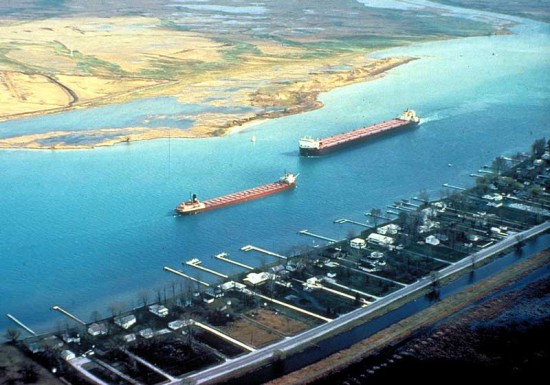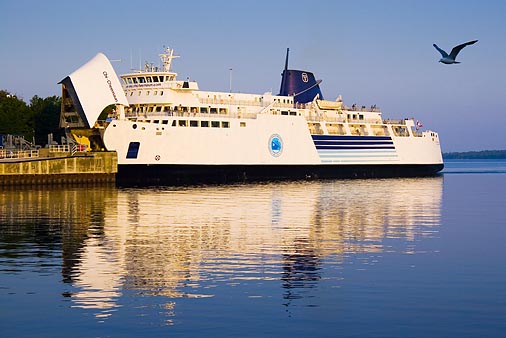LAKE HURON—The International Joint Commission (IJC) is recommending that the US and Canada governments look into some type of structures be put in place on the St. Clair River to slow its outflows and restore the lakes closer to their historic levels. Lakes Huron and Michigan have gone more than 14 consecutive years with below average water levels.
“We are very pleased with what they are recommending,” stated Mary Muter, chair of the Great Lakes section of Sierra Club Ontario. “They have obviously discarded the do nothing approach and are acknowledging the agreement for compensation sills in 1962 with dredging having taken place.”
“I am cautiously optimistic,” said Mike Wilton of the Manitoulin Area Stewardship Committee water committee, referencing the announcement by the IJC. “It sounds great that they are looking at structures being put a the St. Clair River, but there has to be action taken now.”
The IJC had advised the governments of Canada and the United States by letter, dated April 15, that it will implement this year an improved plan for regulating Lake Superior outflows at Sault Ste. Marie. The new plan, Lake Superior Regulation Plan 2012, provides additional benefits compared to current regulations, especially during extreme water supply conditions, a release notes.
In addition, “the Commission has recommended that the governments of Canada and the United States investigate structural options to restore water levels in Lake Michigan-Huron by 13 to 25 centimetres (about five to 10 inches), including a comprehensive cost-benefit analysis and a detailed environmental impact study. Specifically, the commission encouraged governments to focus on options that would not exacerbate future high water levels but that would provide relief during periods of low water.”
“Although future water levels are uncertain, we cannot ignore the damage from record low water levels,” said Joe Comuzzi, Canadian chair of the Commission. “From Georgian Bay to Door County, from shoreline property owners to the shipping industry, we heard calls for action and we urge governments to act in response to our recommendations.”
“What needs to happen now is that agreement of the 1962 and 1930 for compensating measures being taken to restore waters; they need to restore 40 inches of water as per the agreement measures,” said Ms. Muter. “They need to do a full three dimensional model for St. Clair and what can be done responsibly taking in account up and down flow conditions.”
As reported previously, restoration structures investigated by the IJC included sills and underwater hydroelectric turbines located in the St. Clair River that would come at a cost of between $30 and $70 million. It would also take upwards of 20 years for such a commitment to take place, the IJC had warned.
The IJC also recommend that the governments pursue a strategy of adaptive management so the regions can learn to live better with low-and possible high-water levels in the coming years.
Rich Moy, US commissioner said, “while the improvements are modest, the new regulation plan for Lake Superior outflows is better for the environment, better for navigation and better for hydro power generation. But all stakeholders need to be aware that changes in regulation are not the answer to the extremely low levels we are experiencing right now.”
The IJC endorses the study board’s modeling and monitoring recommendations recognizing that critical information and tools are needed to adaptively manage the dynamic system.
In order to better understand how future water supplies may affect water levels, the commission calls upon governments to better coordinate the bi-national collection of climate-related data and strengthen climate change modeling capacity to help improve water management. This approach underpins the adaptive management framework recommended by the study so that decision-makers at all levels of government have the tools and processes to make informed decisions. The IJC will issue specific recommendations regarding adaptive management for the Great Lakes system following its deliberation of the Great Lakes St. Lawrence River Adaptive Management Task Team final report.
“Meeting the ongoing challenges of extreme low and high levels on the Great Lakes should be guided by robust adaptive management to inform decisions, at all levels, with the best information and full community engagement,” said Dereth Giance, US commissioner. “Our goal is for stakeholders throughout the Great Lakes to become engaged in the process and use the latest scientific information to prepare for extreme water levels and storms.”
“We commend and thank the Study Board and the more than 200 experts who worked on this project,” said Lyall Knott, Canadian commissioner. “Their report advances scientific knowledge and provides governments with a solid base for action.”
However, Lana Pollack US chair of the commission, chose not to sign the Commission report because, in her view, it places insufficient emphasis on climate change and the need for governments to pursue and fund adaptive management strategies in the basin. She also cautioned against raising “false hopes that structures in the St. Clair River, if built, would be sufficient to resolve the suffering from low water levels of Lake Michigan-Huron, while at the same time causing possible disruption downstream in Lake St. Clair and Lake Erie.”
The IJC’s advice to governments is in response to the findings and recommendations of the International Upper Great Lakes Study. Originally focused on updating the regulation plan for Lake Superior outflows, the five-year study was expanded to include an examination of whether physical changes in the St. Clair River were affecting the level of Lake Michigan-Huron. At an exploratory level, the Study also looked at various engineering options for restoring Lake Michigan-Huron levels, including approximate construction costs and both positive and negative impacts.
Prior to making these recommendations to the governments, the commission thoroughly reviewed more than 3,500 comments received from the public, including those provided at 13 public hearings held throughout the upper Great Lakes basin last summer, including Manitoulin Island.





